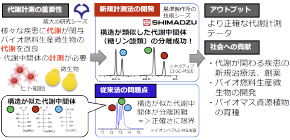
New technology for accurately measuring metabolic pathways
Will facilitate the development of metabolic disorder treatments and microbes for biofuel production
A group of researchers led by Assistant Professor Nobuyuki Okahashi and Professor Fumio Matsuda at the Graduate School of Information Science and Technology, Osaka University, together with a group of researchers led by Visiting Professor Junko Iida (Senior Manager, Shimadzu Corporation), developed technology for accurately analyzing sugar phosphates, intracellular metabolites in glycolysis. This technology has enabled more precise measurements of metabolic flux.
Cells in living things take in sugar, such as glucose from foods, and break it down through glycolysis, a metabolic pathway, to produce energy and precursors, components necessary for synthesis of new cells, during the process. All living organisms carry out glycolysis as part of metabolism and glycolysis is deeply related to various diseases, such as diabetes and cancer. In addition, to produce microbes that produce biofuels, researchers have attempted to improve glycolysis in microbes.
In order to advance these studies, it is necessary to accurately measure some 15 types of glycolytic intermediates. However, it was difficult to isolate and accurately measure glycolytic intermediates (such as sugar phosphates) with conventional approaches because they had similar structures.
The group conducted industry-academia research using gas chromatography-negative chemical ionization-mass spectrometry (GC-NCI-MS) (Shimadzu Corp., Kyoto, Japan), developing a method for the analysis of sugar phosphates with baseline separation. In addition, they used this method to analyze the MCF-7 human breast cancer cell line, succeeding in measurements of metabolic flux 10 times more accurately than conventional methods.
This method will be used for data analysis of various cells and tissues, leading to the development of new treatment methods and drugs. All living organisms engage in metabolic processes, so this technology can be used for microbes that produce biofuels and biomass plants that fix carbon dioxide, contributing to the development of various research such as environmentally-friendly manufacturing.
Abstract
Precise measurement of sugar phosphates in glycolysis and the pentose phosphate (PP) pathway for 13 C-metabolic flux analysis ( 13 C-MFA) is needed to understand cancer-specific metabolism. Although various analytical methods have been proposed, analysis of sugar phosphates is challenging because of the structural similarity of various isomers and low intracellular abundance. In this study, gas chromatography-negative chemical ionization-mass spectrometry (GC-NCI-MS) is applied to sugar phosphate analysis with o-(2,3,4,5,6-pentafluorobenzyl) oxime (PFBO) and trimethylsilyl (TMS) derivatization. Optimization of the GC temperature gradient achieved baseline separation of sugar phosphates in 31 min. Mass spectra showed the predominant generation of fragment ions containing all carbon atoms in the sugar phosphate backbone. The limit of detection of pentose 5-phosphates and hexose 6-phosphates was 10 nM. The method was applied to 13 C-labeling measurement of sugar phosphates for 13 C-MFA of the MCF-7 human breast cancer cell line. 13 C-labeling of sugar phosphates for 13 C-MFA improved the estimation of the net flux and reversible flux of bidirectional reactions in glycolysis and the PP pathway.
Figure 1
The article, “Sugar phosphate analysis with baseline separation and soft ionization by gas chromatography-negativechemical ionization-mass spectrometry improves flux estimation of bidirectional reactions incancer cells”, was published in Metabolic Engineering at DOI: https://doi.org/10.1016/j.ymben.2018.08.011
Related link
